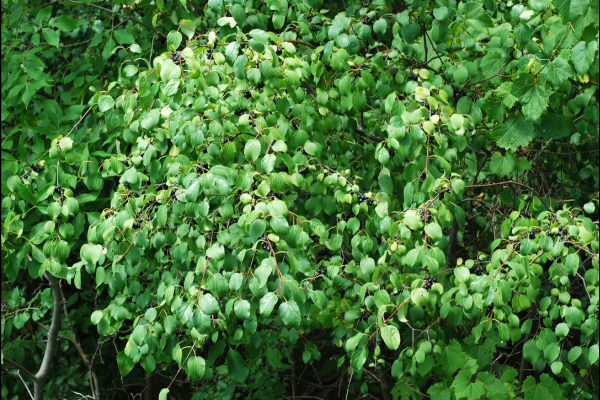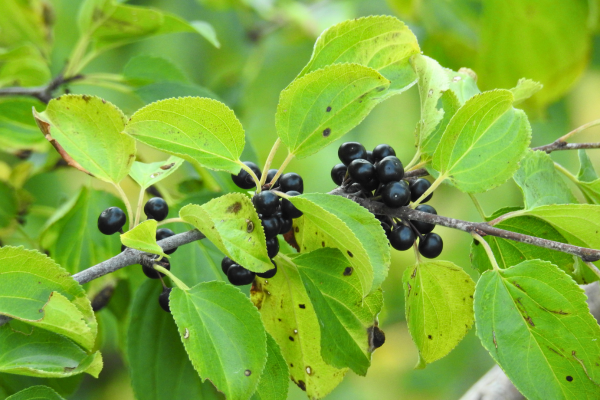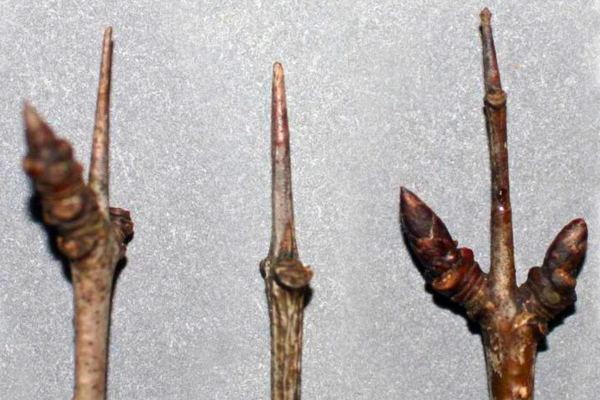
Common buckthorn (Rhamnus cathartica), also known as European buckthorn, is a woody plant that grows as a shrub or small tree. Introduced from Eurasia to North America during the 1880s, it was originally planted as a windbreak for farm fields. It has since spread aggressively throughout southern Ontario and other parts of eastern Canada, thriving along roadsides, fence lines and forest boundaries.

Identifying Common Buckthorn:
Leaves: Buckthorn is one of the first plants to show its leaves in spring and the last to lose them in fall. Look for opposite pairs of small (one to two inch), oval leaves. They are finely toothed and glossy green, often with a slight yellowish tinge in fall.
Fruit: Clusters of small, pea-sized berries that turn dark purple to black as they ripen in late summer and persist through winter.
Branches: Opposite branching with a small thorn at the tip (hence the name "buckthorn").
Bark: Smooth, grayish-brown bark with an orange inner bark that becomes visible when the outer layer is scratched.

Note: Common buckthorn can be mistaken for another invasive species, glossy buckthorn (Frangula alnus), or for a much smaller native shrub, alder-leafed buckthorn (Rhamnus alnifolia).
How Buckthorn Spreads & Its Impact on the Landscape
Several features make common buckthorn invasive across Ontario’s landscape. While berries typically serve as valuable food sources for birds and small mammals, buckthorn berries have a catch: they contain laxative properties. When consumed, the berries quickly pass through the digestive tracts of birds, allowing seeds to disperse in abundance through their droppings while they fly and perch on tree branches. These seeds can remain viable in the soil for up to five years, waiting for the ideal conditions to germinate.
Buckthorns are both shade and drought tolerant, allowing them to establish in diverse environments, especially in disturbed areas. Under ideal conditions, they can reach maturity and produce seeds in a short period of time. As buckthorns grow into tangled hedges, they outcompete native plants for resources like water, space and sunlight. Their shallow roots increase erosion, while their presence alters the nitrogen composition in the soil. This change in soil quality reduces biodiversity by making it harder for native plants to grow.
What Can You Do?
- Educate Yourself: Become familiar with the prevalence of common buckthorn in your area, learn how to identify it and research effective management practices for your property. Check out the Invasive Species Centre for accessible learning resources.
- Manage: Once identified, common buckthorn can be effectively managed through hand pulling, digging or cutting. Be sure to remove as much of the root system as possible to prevent regrowth.
- Dispose Properly: Do not compost buckthorn! Instead, bag and dispose of it in the garbage to prevent seeds from further spread.
- Be Persistent: Common buckthorn control is an ongoing process and complete eradication is rarely possible. Regular monitoring and follow-up treatments are essential to stop the plants from reaching maturity and spreading seeds.
- Replant with Native Species: Replace removed buckthorn with native trees and shrubs to restore habitat and support biodiversity.
- Report Sightings: If you find common buckthorn or other invasive species, visit EDDMapS to report a sighting.
By taking proactive steps, Ontario homeowners can play a crucial role in reducing the spread of common buckthorn and ultimately supporting the restoration of native ecosystems. Actively managing and replacing invasive species with native plants helps protect biodiversity and contribute to healthier, more sustainable environments for future generations.
Jon is an ISA certified arborist and the Residential Planting Programs Senior Field Coordinator at LEAF
LEAF offers a subsidized Backyard Tree Planting Program for private property. The program is supported by the City of Toronto, the Regional Municipality of York, the City of Markham, the Town of Newmarket, the City of Vaughan, the Regional Municipality of Durham, the Town of Ajax, the Municipality of Clarington, the City of Oshawa, the City of Pickering, the Township of Scugog and the Town of Whitby.
